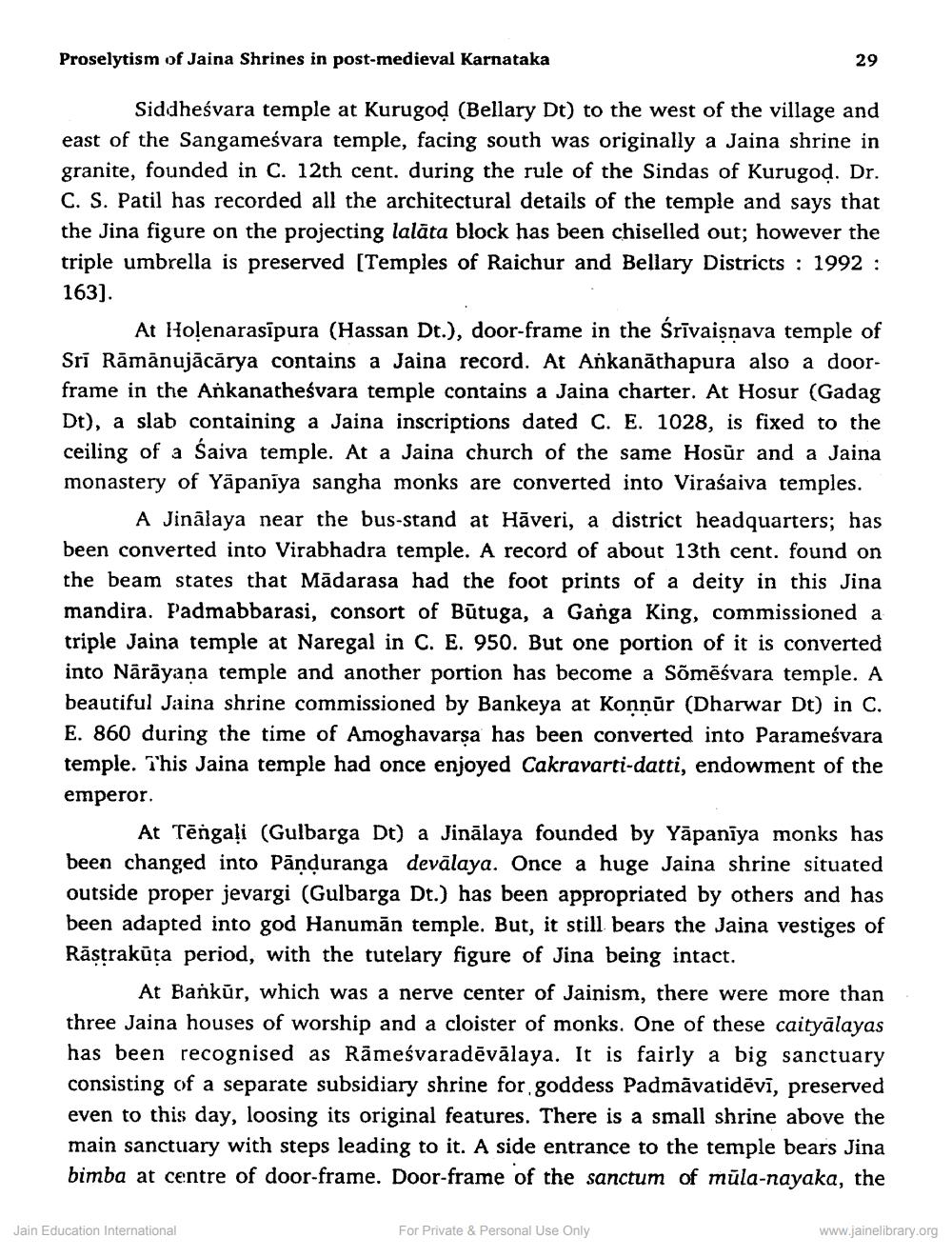________________
Proselytism of Jaina Shrines in post-medieval Karnataka
Siddheśvara temple at Kurugod (Bellary Dt) to the west of the village and east of the Sangameśvara temple, facing south was originally a Jaina shrine in granite, founded in C. 12th cent. during the rule of the Sindas of Kurugod. Dr. C. S. Patil has recorded all the architectural details of the temple and says that the Jina figure on the projecting lalāta block has been chiselled out; however the triple umbrella is preserved [Temples of Raichur and Bellary Districts: 1992: 163].
29
At Holenarasipura (Hassan Dt.), door-frame in the Śrīvaiṣṇava temple of Srī Rāmānujācārya contains a Jaina record. At Ankanathapura also a doorframe in the Ankanatheśvara temple contains a Jaina charter. At Hosur (Gadag Dt), a slab containing a Jaina inscriptions dated C. E. 1028, is fixed to the ceiling of a Śaiva temple. At a Jaina church of the same Hosur and a Jaina monastery of Yapaniya sangha monks are converted into Viraśaiva temples.
A Jinalaya near the bus-stand at Hāveri, a district headquarters; has been converted into Virabhadra temple. A record of about 13th cent. found on the beam states that Madarasa had the foot prints of a deity in this Jina mandira. Padmabbarasi, consort of Būtuga, a Ganga King, commissioned a triple Jaina temple at Naregal in C. E. 950. But one portion of it is converted into Nārāyaṇa temple and another portion has become a Sõmeśvara temple. A beautiful Jaina shrine commissioned by Bankeya at Konṇur (Dharwar Dt) in C. E. 860 during the time of Amoghavarṣa has been converted into Parameśvara temple. This Jaina temple had once enjoyed Cakravarti-datti, endowment of the emperor.
At Tengali (Gulbarga Dt) a Jinalaya founded by Yapaniya monks has been changed into Panduranga devālaya. Once a huge Jaina shrine situated outside proper jevargi (Gulbarga Dt.) has been appropriated by others and has been adapted into god Hanuman temple. But, it still bears the Jaina vestiges of Rāṣṭrakūta period, with the tutelary figure of Jina being intact.
At Bankür, which was a nerve center of Jainism, there were more than three Jaina houses of worship and a cloister of monks. One of these caityālayas has been recognised as Rämeśvaradēvālaya. It is fairly a big sanctuary consisting of a separate subsidiary shrine for goddess Padmavatidēvī, preserved even to this day, loosing its original features. There is a small shrine above the main sanctuary with steps leading to it. A side entrance to the temple bears Jina bimba at centre of door-frame. Door-frame of the sanctum of mula-nayaka, the
Jain Education International
For Private & Personal Use Only
www.jainelibrary.org




